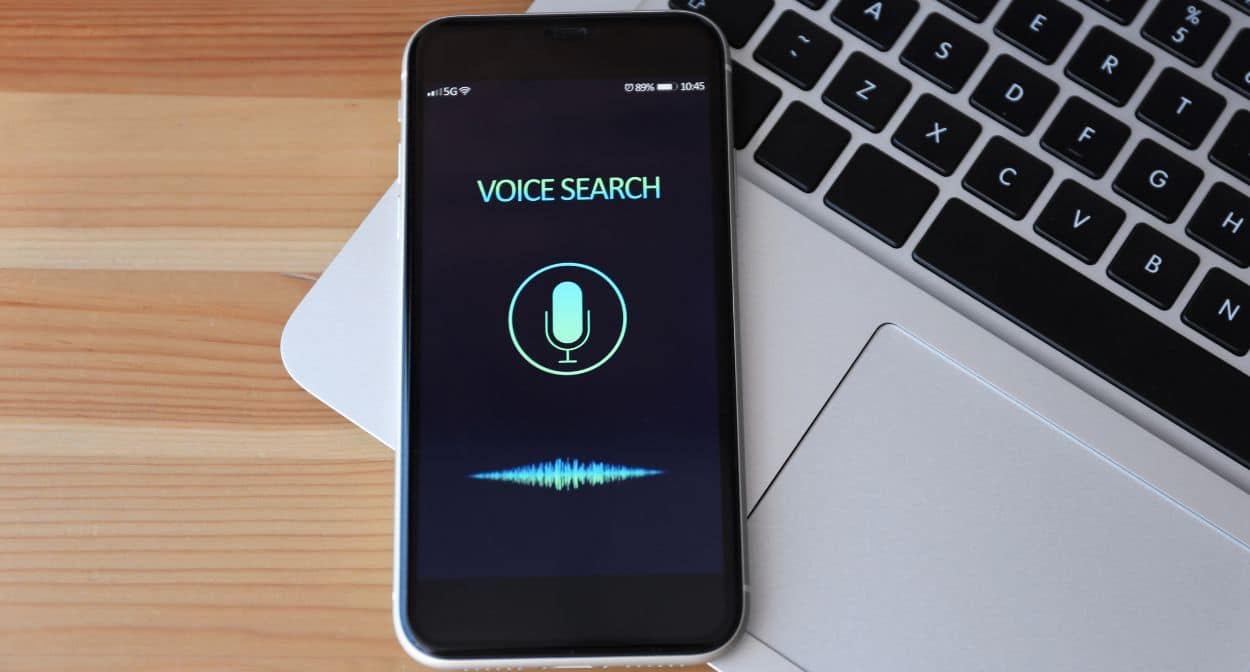Alright, let’s get real for a moment. Voice search optimization?
It sounds like one of those fancy marketing terms that’s more fluff than substance, right?
And it is and it isn’t.
There are a bunch of startups and slick salespeople trying to convince businesses they need to get a new mysterious service called “voice search optimization”, like it’s a new discovery… that’s the deceptive part.
Voice search is being implemented by search engine companies like Google, Bing, Apple, and Amazon/Alexa. THEY are doing something AMAZING in terms of technology and how we use the internet.
But ranking in voice search as a local business is 90% the same as what it takes to rank in existing search engines.
Here’s the thing: it’s not as complicated as it sounds. At its core, it’s all about making sure your local business is easy to find online, whether people are typing on a keyboard or asking Siri for a recommendation.
What Exactly is Voice Search Optimization?

This whole voice search thing is getting pretty popular, and it’s not hard to see why. It’s super convenient, especially when you’re on the go, and let’s be honest, it’s pretty cool too. Plus, for folks who might struggle with typing or reading small text, it’s a game-changer.
Here’s where it gets interesting for local businesses like yours: when people use voice search, they’re often looking for something nearby, and search engines are getting smarter about giving them exactly that. So if someone’s wandering around, asking their phone where to grab a bite, you want to make sure your restaurant pops up as the go-to spot.
Statistics About Voice Search Growth

Overall Growth & Adoption
Global Usage: There are currently 4.2 billion digital voice assistants in use globally, and this number is expected to reach 8.4 billion units by 2024. (DemandSage)
Daily Use: Over 50% of adults worldwide use voice search on a daily basis. (Yaguara)
Smart Speaker Growth: The number of smart speaker owners is rapidly increasing. In 2018, about 1 in 6 Americans owned a smart speaker (NPR & Edison Research).

Mobile Voice Search
Prevalence: 27% of the global online population uses voice search on their mobile devices. (DemandSage)
Surpassing Text Search: Voice search is projected to overtake traditional text-based search in the coming years – potentially with 50% of all searches by 2024. (Yaguara)

Voice Shopping
Sales Impact: Voice shopping is expected to reach $40 billion in sales in the US and UK by 2024. (OC&C Strategy Consultants)
Consumer Habits: 20% of people with smart speakers have made a purchase using voice commands. (eMarketer)

Why This Matters
User Preference: Voice search offers speed, convenience, and hands-free functionality, aligning with evolving consumer preferences.
Natural Language: Voice search mirrors how people naturally speak, allowing for longer, more conversational queries. This changes how businesses need to optimize content.
Local Search: Voice search is heavily used for finding local businesses and information (“restaurants near me”, etc.). Local businesses especially need to adjust their strategies.
The NAP: Core of Local Business Visibility

Here’s the scoop: having your NAP info consistent across all the major online directories is like telling the internet, “Hey, we’re legit!” It builds trust with search engines, and when they trust you, they’re more likely to put you front and center when someone’s looking for what you offer.
If keeping track of all those directories sounds like a headache, I’ve got a hack for you: Moz Local. It’s this nifty tool that helps you manage your business listings all in one place. And if you’re serious about getting the most out of it, the Elite plan is where it’s at.
Now, if all this sounds like a lot to handle on top of running your business, that’s where I come in. My team and I can take care of this for you, so you can focus on what you do best.
Optimizing Your Google Business Profile

Here are some top tips to make your Google Business Profile as snazzy as possible:
- Keep Your NAP Updated: Yep, we’re back to the NAP again. Make sure your name, address, and phone number are up-to-date. It’s simple but super important.
- Tell Your Story: Use the business description section to tell people what makes your business special. Don’t be shy; this is your chance to shine!
- Show, Don’t Just Tell: Upload photos and videos that show off what you do. Whether it’s your cozy café corner or your best-selling product, let people see what they’re missing out on.
- Engage with Your Reviews: Got reviews? Great! Make sure you’re responding to them, good or bad. It shows you value customer feedback and care about your service.
- Encourage Reviews: Don’t be shy about asking your satisfied customers to leave a review. More positive reviews can improve your visibility and make your business more appealing in voice search results.
By giving your Google Business Profile some love, you’re not just making it look good; you’re making it work harder for you in the voice search game.
Fine-Tuning Your Website for Voice Search

Answer People’s Questions: Think about the common questions folks might have related to your business. Use your blog or an FAQ page to answer these with natural, everyday language. Imagine you’re having a conversation with someone right in your shop.
Local Keywords are Key: Sprinkle in phrases like “best pizza in [Your City]” or “24-hour plumber near me.” It’s how real people talk and search, especially when using voice search.
Schema Markup: This is a bit techy, but it’s like giving search engines a roadmap to your site. It helps them understand your content better, making it more likely to pop up in voice searches.
By focusing on these areas, you’re not just optimizing for voice search; you’re making your site more user-friendly overall. It’s a win-win!
Keeping Expectations in Check
Let’s take a moment to talk about expectations. We all want to hit the jackpot with those high-traffic keywords, but the truth is, the competition is fierce. That’s where the beauty of long-tail keywords comes in—those longer, more specific phrases that might not get a ton of searches but are way more likely to lead to actual business.
Here’s the kicker: local searches are your secret weapon. When someone’s looking for a service or product “near me,” or in a specific location, your local business has a fighting chance to stand out. It’s all about making sure you’re the big fish in your local pond.
So, while it’s great to aim for the stars, remember that voice search success often comes from nailing those niche, local queries where you can truly shine.
WordPress for Advanced Users

With WordPress, you’re not just playing in the sandbox; you’re crafting the sandbox itself. This means you can tweak your site to speak directly to voice search engines, making sure your local business isn’t just found, but featured.
Frequently Asked Questions (FAQ) About Voice Search
What is voice search and how does it work?
Why is voice search important for local businesses?
How can I optimize my business for voice search?
Does voice search SEO differ from traditional SEO?
How can I measure the success of my voice search optimization efforts?
Are there any tools to help with voice search optimization?
How often should I update my business information for voice search optimization?
Conclusion
So, what have we learned on this voice search optimization journey? First off, your NAP needs to be as consistent as a morning coffee routine. Then, there’s your Google Business Profile—think of it as your digital shop window, so make sure it’s looking sharp. And don’t forget about on-site SEO; it’s the bread and butter of your online presence.
Remember, optimizing for voice search isn’t about pulling a rabbit out of a hat. It’s about building on the rock-solid foundation of local SEO practices you’ve already laid down.
Now, it’s your turn. Take a moment to audit your NAP consistency across the web. Spot any discrepancies? It might be time for a little tune-up.


